Hi-Fi Hall of Fame
Business Inductee
SONOS

Introduction
Our next inductee is Sonos, a Hi-Fi equipment manufacturer that specializes in wireless speakers. The company was founded in 2002, when wireless technologies such as Wi-Fi and Bluetooth were just beginning to become ubiquitous. Sonos engineers developed many of the technologies and tools required to make these wireless technologies suitable for hi-fi applications.
Today, Sonos products include home speakers, soundbars and subwoofers that can be connected and controlled through a dedicated application on the user’s mobile phone. They also make portable wireless speakers that can be used anywhere.
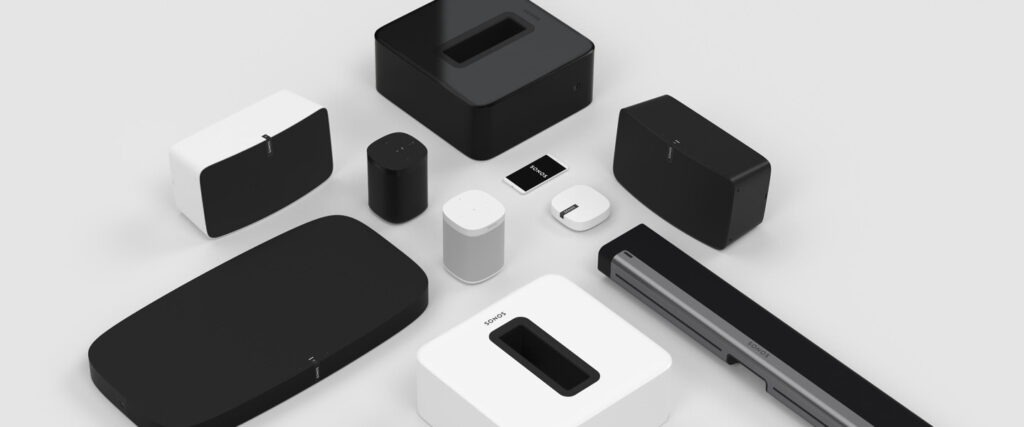
One of the key features of Sonos is its focus on multi-room audio. Users can set up multiple speakers in different rooms of their homes and synchronize them to play the same music or different tracks simultaneously. The Sonos system relies on a wireless mesh network to connect and communicate between devices, allowing for a seamless audio experience throughout the home.

The Sonos ecosystem is also known for its compatibility with various streaming services, allowing users to play music, podcasts, and other audio content from platforms like Spotify, Apple Music, Amazon Music, and more.
In addition to its audio products, Sonos has integrated voice control capabilities, often supporting virtual assistants like Amazon Alexa and Google Assistant, enabling users to control their devices using voice commands.
Key Facts
| Company | SONOS |
| Business | Wireless Speakers |
| Key Technologies | Wireless mesh networking SONOS operating system TruePlay room equalization |
| Founded | 2002 |
| Website: | http://www.sonos.com |
Sonos History: From Startup to Success
Sonos was started in 2002 by four founders: John MacFarlane, Tom Cullen, Trung Mai, and Craig Shelburne. This group had a lot of success with their first Internet-based business venture, creating a company called software.com. After selling that business, for their next venture, they decided to start up a company that would offer a new way to bring music to every home – wirelessly, in multiple rooms, from a variety of devices, with high fidelity sound.
The new company was initially called Rincon Audio. It operated under that name from 2002 to 2004 before changing the name to Sonos. The vision for the new company was driven by “four big insights” held by the founders.
First, that the proliferation of industry standards for data and wireless networks meant that the Internet could be treated as a programmable platform, to deliver information and content to users anywhere on a wide range of devices.
Second, that the collapse of costs for the “brains” of computers, Wi-Fi access points, and mobile phones – the integrated circuits, central processing units, and other technologies – meant that these components were fast becoming commodities.
Third, the four founders could see that the Internet was going to revolutionize and accelerate the “digitization” of data, that this revolution was just getting started in 2002, creating nearly unlimited potential business opportunities.
Fourth, that data networking would be possible not just for large scale services, such as music streaming services with a global footprint, but also for small scale services, such as a local area network in the home for private music streaming throughout a home or office.
Three years after the company was founded, in early 2005, Sonos shipped its first product. The Sonos Digital Music System was comprised of two components: the Sonos ZonePlayer, a networked audio player that distributes, plays and amplifies music in any “zone” in the home, and the Sonos Controller, a wireless handheld device with a full-color screen which allowed the user to access, customize and control the music anywhere, from the bedroom to the backyard.
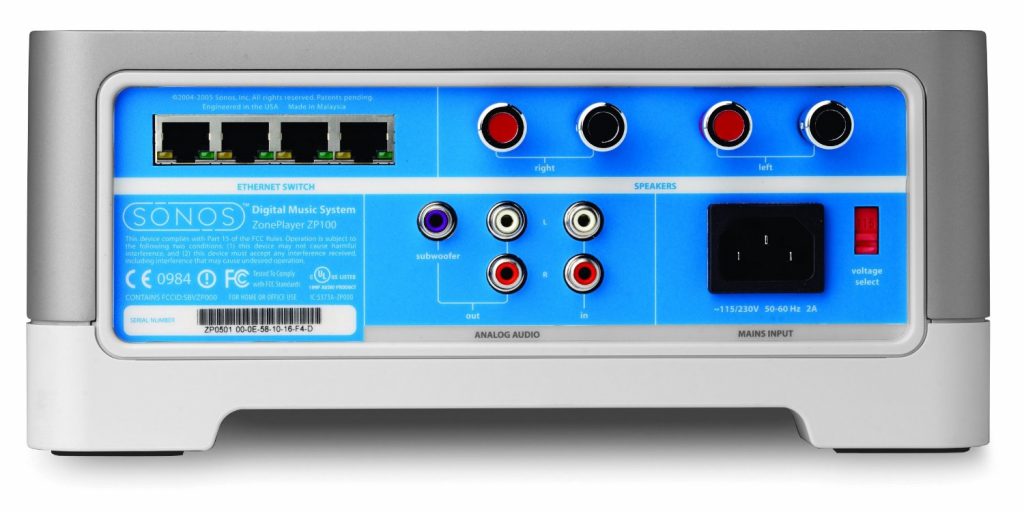

The ZonePlayer (later renamed the ZP100) incorporated a 50 watt per channel stereo amplifier with high fidelity specifications. It could access and play a wide variety of music formats, including MP3, WMA, AAC (MPEG4) and WAV, stored on a computer or Network Attached Storage (NAS), and it also supported access to a number of Internet Radio stations. The product was well reviewed, as people liked the ease of use and sound quality.
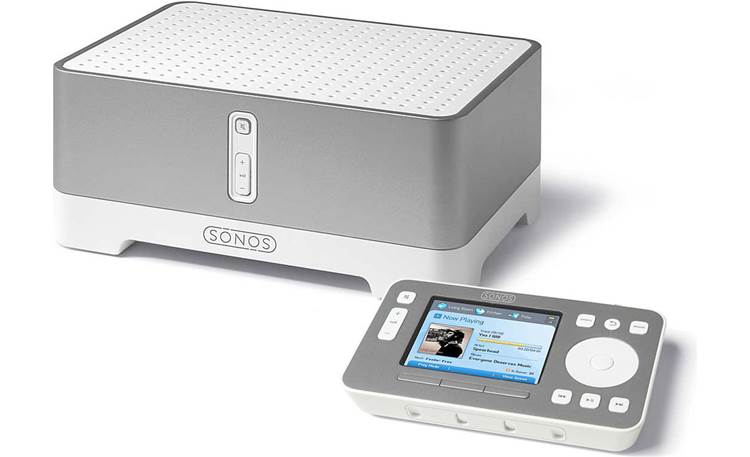
A year later, in 2006, Sonos released the ZP80, which was similar to the ZP100 but did not include an amplifier, so that people could use it with their existing stereo systems.

Apple’s iPhone and iPod were becoming very popular around the same time, so in 2008 Sonos developed an iOS application that would allow users to control the Sonos equipment from their iPhone or iPod, eliminating the need for a physical Sonos controller.

In 2009, Sonos released their first wireless speaker, the ZonePlayer S5. This speaker was groundbreaking, as there were very few wireless speakers available at that time. It was technically far ahead of the few competitors that it did have. First, it was a standalone device, with it’s own direct connection to the Internet via Wi-Fi, so there was no need for a dedicated “hub” device. Second, it could stream audio from a wide variety of sources, either from the Internet or from the user’s own audio system. Third, it was controlled by a simple to use, free app on an iPhone. Fourth, it operated on a secure “mesh” network in the home which could be easily expanded with additional Sonos speakers.
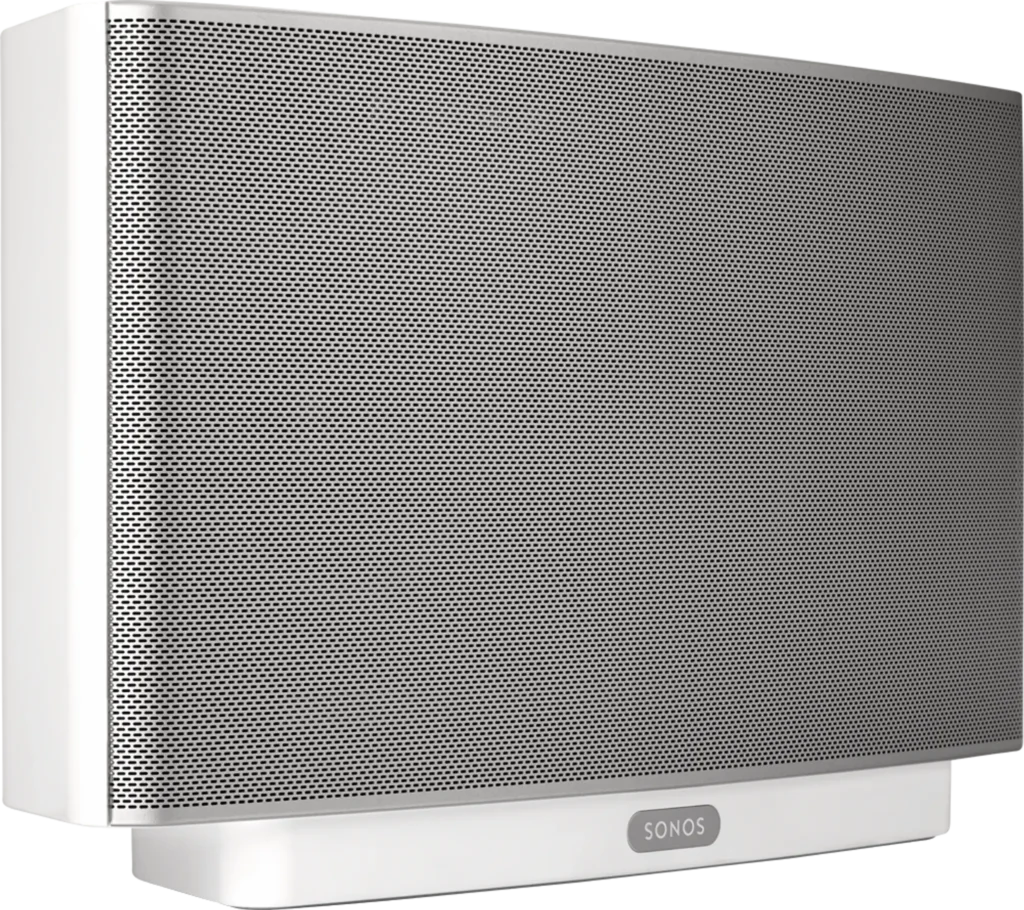
With all these advantages, Sonos quickly went from startup to success story. The company released a steady stream of new products, with new technologies and various form factors. Sonos partnered with many of the major music streaming services, and they now have more than fifty streaming service partners, so there is lots of content available. Sonos also continued to innovate, and now claim to hold more than 2000 patents. Sonos have been expanding their distribution as well, and offer products in more than 60 countries.
If you’d like to read the official story of how Sonos got started, you can see it on the company’s website:
Innovation: the Key to SONOS Success
From their inception, Sonos has been developing innovative solutions that have enhanced the user experience while still delivering high fidelity audio.
Their first innovation was the hardware-based home network that made it possible to enjoy music throughout the home without running wires. But that solution required a physical bridge and a physical controller that added cost and complexity. So what did Sonos do? They developed a solution that streamed music directly from the the Wi-Fi access point in the home to the speakers, eliminating the need for the bridge.
Sonos’ next big innovation was to eliminate the need for a physical controller. With the launch of the iPhone in 2007 and Apple’s App Store sparking a boom for apps, Sonos launched its own, free app for iPhone users, meaning you could turn your iPhone into a Sonos controller. Sonos developed an Android app in 2011, and Sonos phased out the controller hardware in 2012.
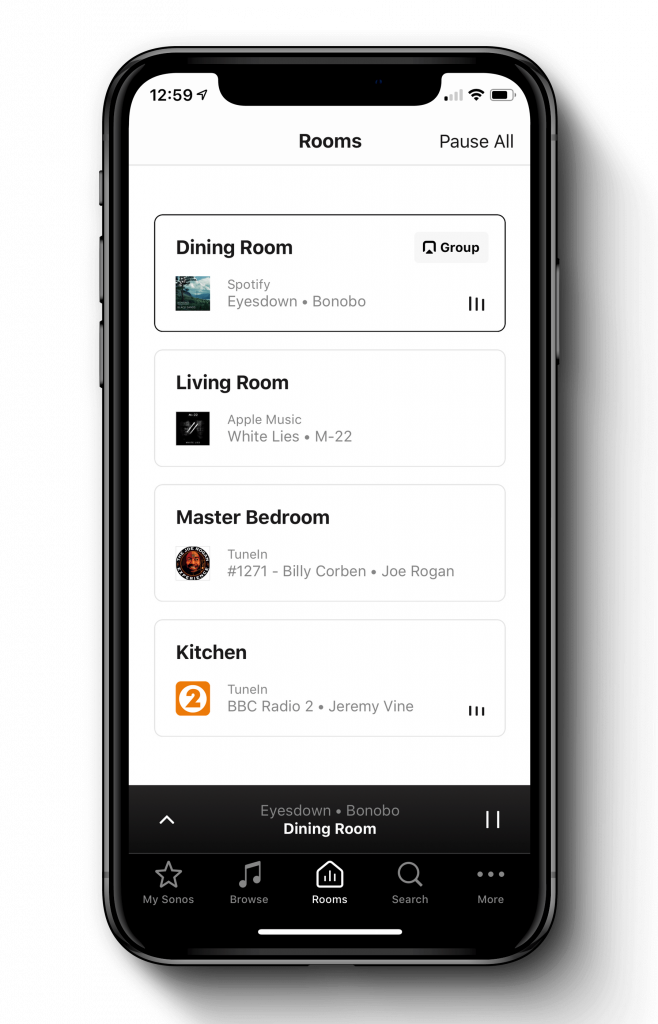
Another big innovation was a technology called “Trueplay”, developed in conjunction with music producers, musicians and composers. TruePlay, launched in 2015, allows users to automatically adjust the audio settings of their Sonos speakers to optimize sound quality based on the specific acoustics of the room. The Trueplay technology uses the microphone on a mobile device (such as an iPhone or iPad) to measure how sound waves are reflecting off walls, furniture, and other surfaces in the room. It then analyzes this data and adjusts the speaker’s equalization settings to deliver the best possible sound for that particular environment.

In 2019, Sonos partnered with IKEA to create a line of smart speakers and audio accessories that integrate seamlessly with IKEA’s furniture and home decor. The collaboration resulted in a product line called “Symfonisk,” which combines IKEA’s design expertise with Sonos’ audio technology. The Symfonisk line includes products such as a table lamp with an integrated Sonos speaker and a bookshelf speaker that can also function as a wall shelf. These products are designed to blend into the home environment, serving dual purposes as both functional furniture and high-quality audio devices.

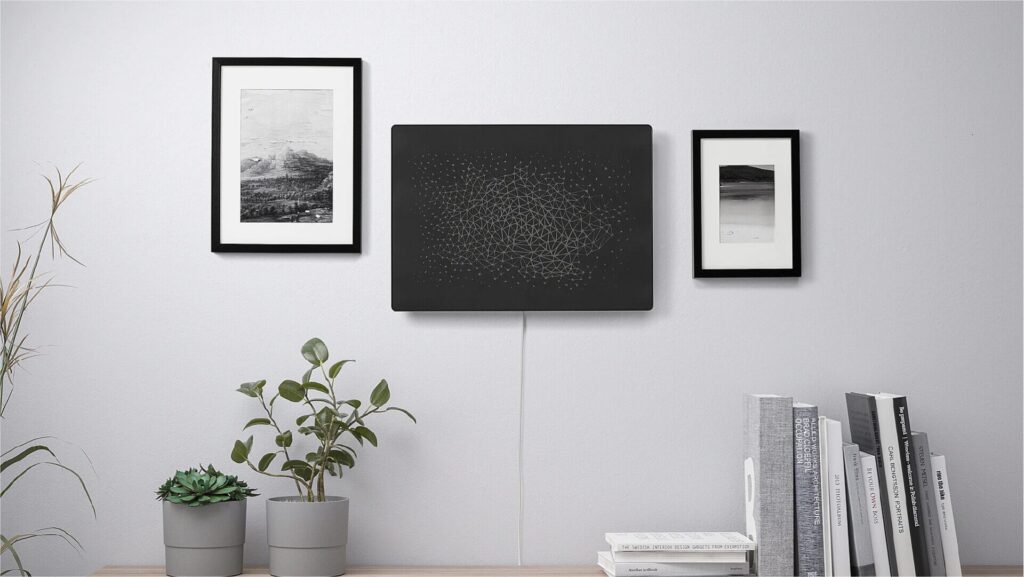
SONOS Most Essential Products and Capabilities
Sonos has produced a number of great products over the years, but a few of them stand out as the most essential to their success. Let’s focus on a few of those.
Play:3 speaker (2011)
Play:3 was a smaller, more affordable amplified speaker in Sonos’ lineup of smart speakers. It was a two-way speaker with two woofers and a tweeter and could be used in a Sonos multi-room system. The Play:3 could also be paired to support stereo sound.

SUB wireless subwoofer. (2012)
The SUB was Sonos’ first subwoofer, and integrated easily into a Sonos system. It employed a pair of woofers enclosed in a distinctively shaped cabinet.
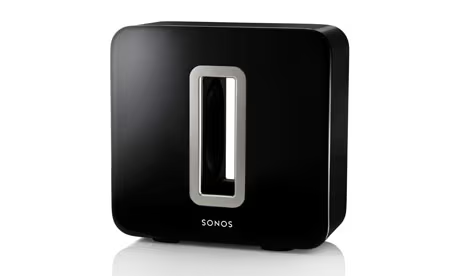
PLAYBAR soundbar (2013)
PLAYBAR was Sonos’ first soundbar, a key component in creating a Sonos home theater system. It could be used as a standalone soundbar or paired with other Sonos speakers, such as the Sonos Sub for added bass and Sonos speakers for surround sound. Equipped with nine individual speakers, six “midwoofers” and three tweeters, the PLAYBAR delivered high fidelity sound.

Play:1 (2013)
Play:1 was Sonos’ third smart speaker. It was the smallest speaker in the lineup, and employed a woofer and tweeter and a pair of “Class D” amplifiers. Despite the low cost and small size, it incorporated all of the usual Sonos capabilities.
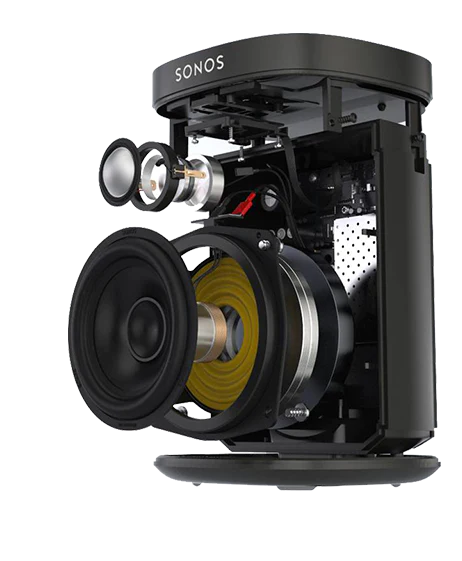
Play:5 (2015)
A second generation Play:5 speaker was released in 2015. It employed three woofers and three tweeters each powered by it’s own amplifier.
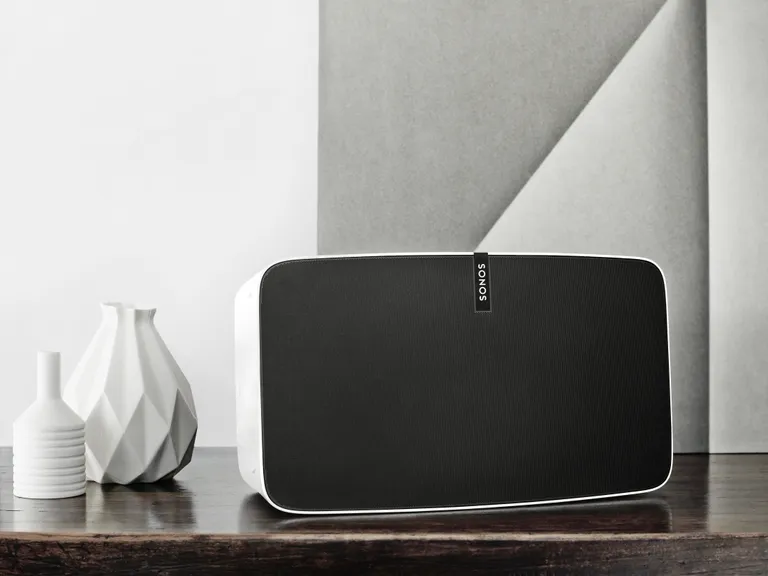
Voice Control (2017)
In 2017, Sonos began building voice control capabilities (such as Amazon Alexa) into their products. This allowed the user to search for music and adjust the sound using spoken commands.

SYMFONISK (2019)
The first two products resulting from the IKEA-Sonos collaboration, called SYMFONISK, a small bookshelf speaker and a combination table lamp/speaker, became available from IKEA.

MOVE (2019)
In 2019 Sonos introduced their first battery operated Sonos speaker called Move. The speaker was portable and had an environmental rating of IP56 making it humidity, heat, and cold resistant. It used an indoor charging base and could play up to 10 hours on a full charge.

Port (2019)
In 2019 Sonos released “Port” which is an updated version of the Connect network audio player. Port connects to any audio component (such as a turntable or cassette deck) for listening on your Sonos wireless multi-room audio system, and it can also play your streaming music sources (such as Apple Music or TIDAL) through just about any powered speakers or home audio system.
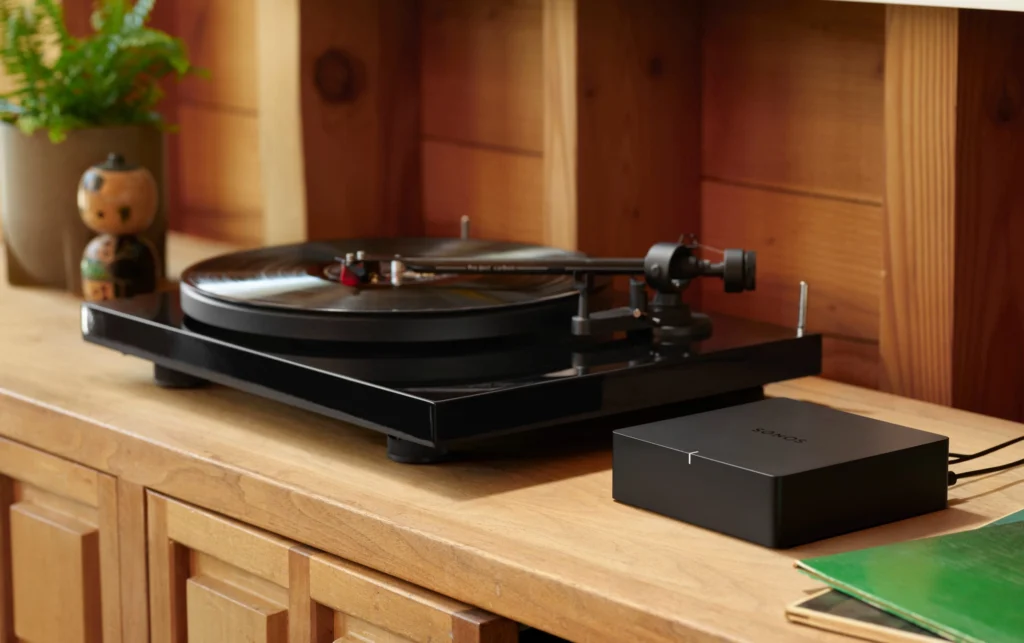
Sub Mini (2022)
2022 saw the launched of Sonos Sub Mini wireless subwoofer. The Sub Mini employs a pair of 6 inch woofers each powered by its own Class D amplifier. Despite its small size, the Sub Mini plays down as low as 25 Hz and employs TruePlay and equalization to tune the low frequency performance.

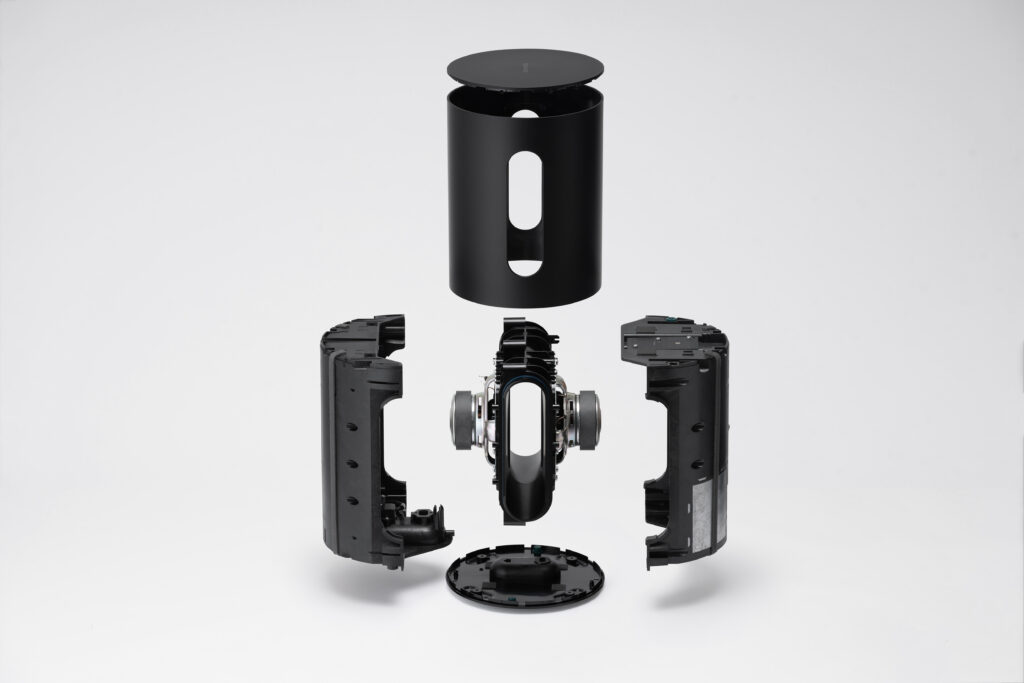
ERA 100 and ERA 300 Speakers (2023)
Sonos “ERA” speakers were released in 2023 and support a number of incremental improvements over the earlier “One” and “Three” models that they replace. They offer superior audio quality, with larger drivers and more powerful amplifiers and enhanced connectivity.
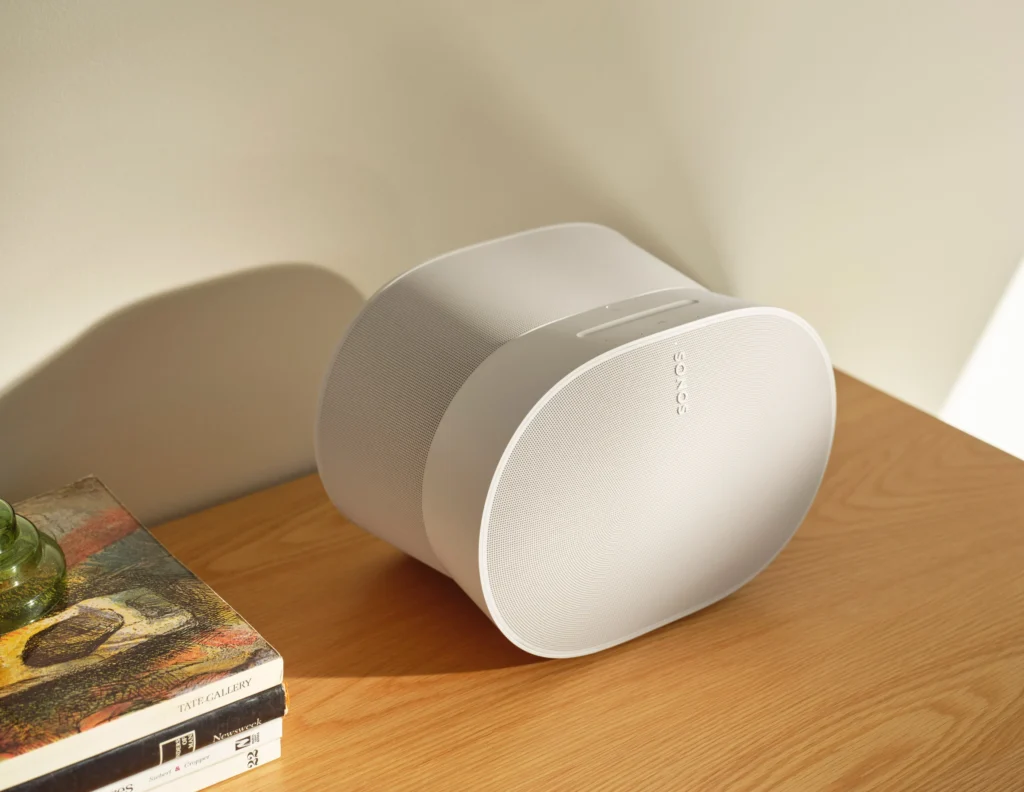
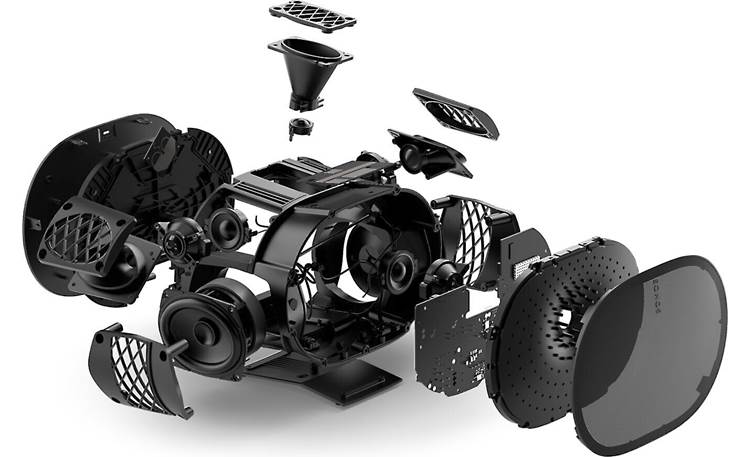
SONOS Impact on Hi-Fi
Although Sonos is a relatively new entrant to the Hi-Fi world, the company has had a notable impact on the Hi-Fi industry and community. Here are some of their contributions:
Wireless Multi-Room Audio
Sonos popularized and pioneered the concept of wireless multi-room audio systems. The ability to synchronize and control speakers in different rooms wirelessly has become a significant trend in the Hi-Fi industry, influencing both consumer expectations and industry developments.
Simplified Setup and User Experience
Sonos focused on creating a user-friendly experience for setting up and managing Hi-Fi audio systems. The simplicity of the Sonos ecosystem, with easy wireless connectivity and intuitive control through a mobile app, has set a standard for user convenience in the Hi-Fi space.
Integration of Streaming Services
Sonos seamlessly integrates with various streaming services, allowing users to access a vast library of music from platforms like Spotify, Apple Music, and others. This integration has contributed to the shift from physical media to digital streaming in the Hi-Fi community.
Accessibility and Affordability
While traditional Hi-Fi systems could be complex and expensive, Sonos aimed to make high-quality audio more accessible. The brand introduced a range of products at different price points, catering to a broader audience and making Hi-Fi experiences attainable for more consumers.
Innovation in Speaker Design
Sonos has been known for its innovative speaker designs, balancing aesthetics with audio performance. Products like the Sonos Play:5 and Sonos Beam have demonstrated a commitment to delivering both quality sound and a visually appealing form factor.
Ecosystem Approach
Sonos follows an ecosystem approach, encouraging users to build upon their audio setup by adding additional speakers or components. This modularity has influenced other manufacturers to consider interoperability and expandability in their product offerings.
Adaptation to Changing Trends
The Hi-Fi industry has seen changes in consumer behavior, with a shift towards wireless and smart home technologies. Sonos has adapted to these trends by incorporating voice control, supporting virtual assistants like Amazon Alexa and Google Assistant, and continually updating its products through software enhancements.
Induction to the Hi-Fi Hall of Fame
Sonos took a simple problem – how to get rid of all of those wires connecting an amplifier to speakers – and developed an elegant solution, while maintaining the high fidelity performance that people expect. Sonos accomplished did this by developing a novel wireless network that serves the whole home, and by controlling it with a simple, intuitive controller.
Then over time, Sonos added all of the modern updates to meet the needs of 21st century consumers: streaming audio, smartphone “apps” to control the system, home theatre speakers, outdoor speakers, portable speakers, subwoofers, and lots more. And all of the components that Sonos have ever produced are capable of Hi-Fi sound.
For all of their contributions, SONOS is inducted into the Hi-Fi Hall of Fame.
